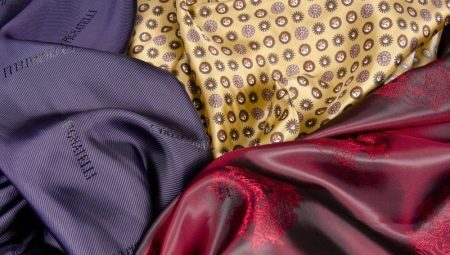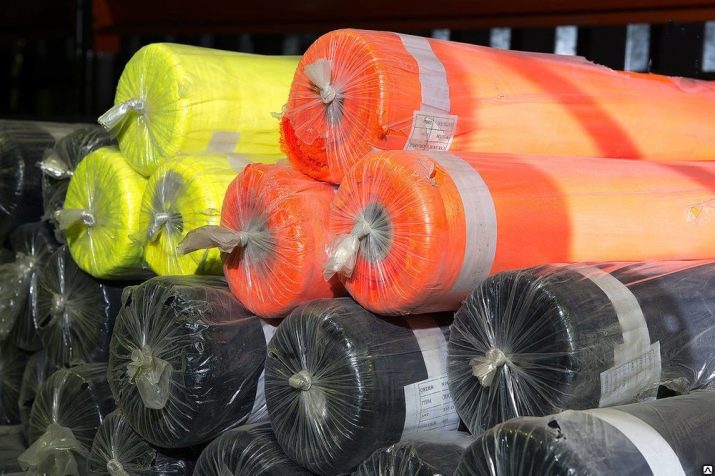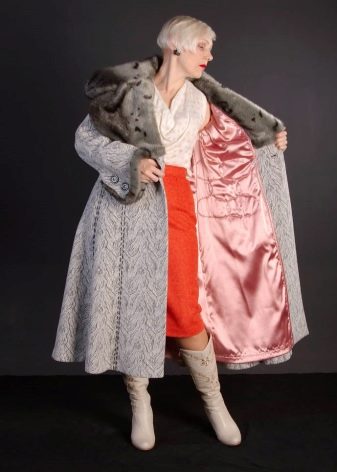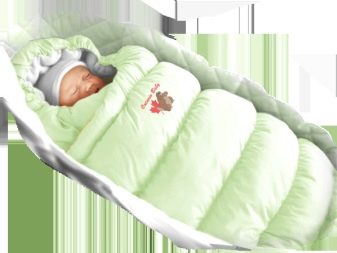Lining fabric: types and selection rules

Lining fabric is an indispensable item for sewing many types of clothing. Most people don't pay attention to it at all. However, the lining plays a significant role in the garment. With its help, some fabrics do not crumble on sections, things "keep" their shape well, and also maintain the necessary microclimate. Currently, there is a huge selection of different options for lining fabrics. Thanks to the wide range of materials, it is very easy to choose the option you need.



Composition and properties
Lining fabric is needed to decorate things from the wrong side. This is to keep the garment safe and to prevent rapid wear and tear or contamination. All lining fabrics are subject to strong friction during wear.
The main qualities of the lining:
- with frequent washing, the material must retain a presentable appearance;
- it is necessary that the paint on the fabric is of high quality and durable, especially with friction and other types of exposure;
- the lining should be easy to process;
- the material must be hypoallergenic;
- it is necessary that the fabric has good hygienic characteristics;
- the material should not be highly electrified.
The lining should be light, durable, wear-resistant, give little shrinkage during washing, as well as have a reasonable price and durable color of the material.

Lining fabric classification:
- the material is subdivided according to its composition into cotton, silk, woolen, homogeneous and mixed structure;
- according to the production method, it can be fabric, knitted fabric or fur;
- the material can be made from yarn or thread;
- by color it is divided into bleached, dyed or variegated.
The lining should match the properties of the upper fabric. It is customary to divide it according to the density of the material into light, medium and heavy fabrics. There is a special GOST for lining fabrics with chemical fibers and yarns. On the basis of such standards, the manufacturer must produce only high-quality materials that meet all the necessary requirements.
There is another classification by composition, the lining material is subdivided into:
- natural fabric (flannel or natural silk);
- unnatural fabrics (the most famous is viscose);
- synthetic (mesh or polyester).



Advantages and disadvantages
Lining fabrics based on natural and chemical fibers are widely available for sale.
Advantages of natural materials:
- do not accumulate static electricity;
- vapor permeable;
- allow air to pass through;
- are hygroscopic;
- they have high thermal insulation characteristics;
- very beautiful and prestigious.

In addition to positive qualities, natural lining materials have a number of disadvantages:
- crumple very quickly;
- the color intensity disappears quickly;
- can strongly change shape when worn or improperly washed;
- quickly absorb moisture and dry for quite a long time.
Advantages of chemical fibers:
- these lining materials practically do not wrinkle;
- due to their technical characteristics, they allow you to make a brighter and more interesting color;
- practically do not change their shape with prolonged wear and frequent washing;
- some types of linings can be very elastic;
- dry quickly and do not lose their shape.


In addition to the advantages, these materials also have disadvantages:
- unnatural lining fabrics have low air permeability;
- hardly absorb moisture;
- may cause allergies;
- able to store static electricity;
- have low heat-shielding properties.

Types and their characteristics
Nowadays there is a huge variety of clothing and accessories that require lining. Most often, manufacturers use synthetic materials. They have a longer service life and lower cost.
There is a huge variety of fabrics on the light industry market.
Atlas is a material with a smooth and even surface.
Atlas stretch has a unique shiny surface, which is created using modern weaving technology.
The main characteristics of the atlas:
- it has a dense and even structure;
- keeps its shape perfectly;
- has good wear resistance;
- the fabric has a beautiful appearance;
- it is safe and hygienic;
- the fabric has an anti-static effect.


This type of lining fabric is used in the manufacture of suits, coats, fur coats, various bags and gloves. Atlas is very finicky. This is a very dense fabric. It actively absorbs dirt, which requires careful and careful handling of such a thing. And also it has an off-budget cost and is suitable for premium items.
Viscose is made from processed wood pulp. However, you should not class it as a chemical tissue.
The main characteristics of viscose:
- the fabric creates a soft slip;
- has a democratic value;
- does not accumulate static electricity;
- very easy to color;
- absorbs any moisture well;
- has hypoallergenic properties.
Viscose is great as a lining for casual wear. It goes well with summer wardrobe items and, thanks to its synthetic composition, has a long service life. Viscose also allows you to keep warm for a long time, which makes it popular as a lining for outerwear.


An unnatural fabric called cupro is also used for the lining.It was created at the beginning of the 20th century. It is based on viscose using copper and ammonia fibers.
The main advantages of cupro:
- the material has a soft structure;
- high strength;
- the lining of this fabric is very elastic and resilient;
- has high color fastness;
- it is very smooth and pleasant to the touch;
- has high breathability and hygroscopicity.
This lining will not wrinkle if it is with elastane. The material is very often used in the manufacture of men's suits and outerwear.
Cupro is an expensive type of viscose.

Polyester is an unnatural fabric similar to wool.
The main advantages of polyester:
- the material is highly durable;
- has a democratic cost;
- very little wrinkles during operation;
- has high resistance to light and heat;
- unpretentious in care;
- has high antistatic properties.
It is customary to make lining for outerwear and leather goods from this type of material.
However, the material has little air permeability. It does not absorb water well and is more suitable for winter clothes.


Silk and cotton fibers are used for the manufacture of satin. Due to the weaving technology, the thread has a dense structure.
The main advantages of satin:
- high material density;
- heat-resistant fabric that practically does not wrinkle;
- has good wear resistance characteristics.
It is used for fur coats made of natural fur, for sewing skirts, trousers and jackets.


Mesh is a material with a special kind of weaving. It can be small or large. In the form of a lining fabric, it is worth choosing a soft mesh, which contains natural fibers.
The main advantages of the mesh:
- has high breathability;
- keeps warm;
- very light;
- quite easy to handle and maintain.
The mesh is used as a lining for fitness suits and dresses with puffy skirts for a special celebration. It acts as a lining in sports backpacks.

Flannel is a warm and very pleasant fabric.
The main advantages of flannel:
- pleasant to the touch and very soft;
- has good strength and long service life;
- does not cause allergies.
When worn for a long time, the fabric can wrinkle and roll. This lining material is used in children's clothing, toddler envelopes and in trousers and jackets for adults. A wonderful fabric that keeps you warm from the cold. The width of the material allows it to be used as a lining in baby strollers.


Quilted fabric is a material that has been stitched to a specific pattern. It can be on padding polyester or with insulation from other materials. Most often, due to the stitching, some kind of filler is kept inside. It can be windproof, knitted or flame retardant thin fabric that slips and does not cling to clothing. It is mainly used for coats or down jackets. And also this type of lining is used for bags.
More recently, foil lining has appeared on the fabric market. It is non-slip, developed using modern technology and silver ions. The material is obtained from polyester fibers.
This lining keeps you warm. It is used as a lining in the manufacture of sports jackets and down jackets.


Colors
The range of lining materials is impressive. Apparel uses more than just the standard shades of white, black and blue. Very often red, pink, yellow and light green fabrics are used. Reversible lining fabric is in vogue, which serves as an excellent decoration for any outerwear. Many coats and suits began to be sewn using multi-colored lining and patterned materials. They give character and style to the image.
Recently, the lining and the main fabric may not match in color and be contrasting.

How to choose?
Lining fabric is a great addition to keep your garment in top condition. It helps to hide all the details of the material processing in the form of seams and uneven edges, which can crumble. Different fabric variations are used for each item.
There are several basic rules for choosing a lining.
- The smooth surface allows the fabric to slide. This contributes to the fact that the clothes do not cling to other toilet items, various puffs do not form on it.
- Synthetic material has a more durable structure and can withstand more loads than natural.
- It is best that the lining does not show through, allowing you to hide all the internal seams of the product.
- It is necessary to look closely at materials that do not cause allergic reactions, allow air to circulate and are lightweight, so as not to give the impression of being too bulky.


A quality product keeps its shape well and does not deform when moisture gets in. The dense material with a smooth surface allows you to well hide all the seams. For double-sided fabrics, choose a mesh lining.
The quality characteristics of the lining fabric determine how long it will last and retain its original properties.
In recent years, manufacturers have begun to offer consumers lining fabrics of very bright colors and from various materials. Such a lining can decorate any item. The Italian lining is very popular. There are also manufacturers of lining fabrics in Russia. Both inexpensive fabrics and fabrics of higher quality and, accordingly, high cost are on sale.

Application
Lining fabric is common in light industry. It is used when sewing business suits. It serves to maintain the shape and density of skirts and dresses. In summer clothes, lining is used so that light things do not shine through and do not stick to the body.
Many types of lining materials are used to decorate leather goods. It is possible to sew curtains or upholstery from it. Satin or satin is perfect for curtains.
How to determine the quality of the lining fabric is described in the next video.









I agree with the opinion that the lining fabric affects the finished product as a whole. That is why I am very attentive to the choice.